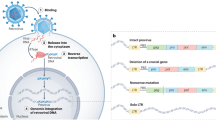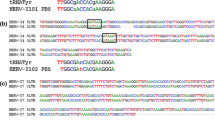Summary
We examined effects of aging on endogenous retrovirus gene expression of mouse lymphocytes with a hypothesis that it may be a useful biomarker of aging. Mice have endogenous murine leukemia viruses (MuLVs) in their chromosomes. We detected the gene expression of long terminal repeats (LTRs) of MuLVs. Brains, livers and spleens were taken from young (3 months old) and old (27 months old) male C57BL/6 mice. In addition to these control (C) mice, we also determined gene expression in dietary restricted (DR) mice, in which rates of aging are known to be slowed. RNA was extracted from the tissues and converted into cDNA. The MuLV-LTR portion of cDNA was amplified by polymerase chain reaction (PCR). The PCR products were analyzed by agarose gel electrophoresis. Gene expressions of young mice were found to be tissue-specific. Expressed LTRs from brains, livers and spleens were that of 370 base-pairs (bp), those of 370 and 620 bp, and those of 370, 400 and 620 bp, respectively. Old mice of C group, however, decreased tissue specificity: expressed LTRs became those of 370–400 by in any tissues. In contrast the tissue specific gene expression was conserved in old DR mice which had to get prolonged life span and decreased lymphoma incidence. Thereby, gene expression of endogenous retroviruses appears to change during aging and to be modifiable by life-prolonging DR. It may be therefore used as a biomaker of aging in mice. Humans are known to have similar gene elements like MuLV. The present findings demonstrate a possibility of application of endogenous gene expressions to the epidemiology of aging.
Similar content being viewed by others
References
Chomczynski P, Sacchi N (1987) Single step method of RNA isolation by acid guanidium thiocyanate-phenol-chloroform extraction. Anal Biochem 162: 156–159
Gad SC, Weil CS (1989) Statistics for toxicologist. In: Hays AW (ed) Principles and methods of toxicology, 2nd ed. Raven Press, New York, pp 273–320
Koizumi A, Wada Y, Tsukada M, Kamiyama S, Weindruch R (1990) Effects of energy restriction on mouse mammary tumor virus mRNA levels in mammary glands and uterus and on uterine endometrial hyperplasia and pituitary histology in C3H/SHN F1 mice. J Nutr 120: 1401–1411
Lowy DR (1985) Transformation and oncogenesis: Retroviruses. In Fields BN et al. (eds) Virology. Raven Press, New York, pp 235–263
Maniatis T, Fritsh EF, Sambrook, J (1982) Molecular cloning: A laboratory manual. Cold Sprig Harbor Laboratory, Cold Sprig Harbor, New York
Mooradian AD (1990) Biomarkers of aging: do we know what to look for? J Gerontol 45:B183-B186
Rassart E, Shang M, Boie Y, Jolicoeur P (1986) Studies on emerging radiation leukemia virus variants in C57BL/Ka mice. J Virol 58:96–106
Stoyle JP, Coffin JM (1987) The four classes of endogenous murine leukemia virus: Structural relationships and potential for recombination. J Virol 61:2659–2669
Author information
Authors and Affiliations
Rights and permissions
About this article
Cite this article
Wada, Y., Tsukada, M., Kamiyama, S. et al. Retroviral gene expression as a possible biomarker of aging. Int. Arch Occup Environ Heath 65 (Suppl 1), S235–S240 (1993). https://doi.org/10.1007/BF00381349
Issue Date:
DOI: https://doi.org/10.1007/BF00381349




